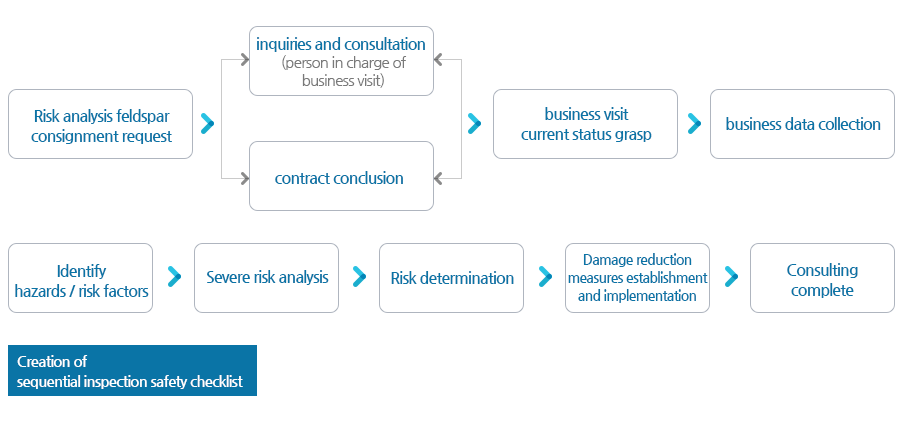- About Us
-
Ex Training
Ex Training
-
Ex Training
Ex Training
-
Ex Training
-
Ex Consulting
Ex Consulting
-
Accreditation
Accreditation
- European Accreditation
- Korean Accreditation
-
Int'l Accreditation
Int'l Accreditation
-
Construction
Construction
-
Accreditation
-
Management System Consulting
Management System Consulting
- ISO Consulting
-
Occupational Safety & Environmental Consulting
Occupational Safety & Environmental Consulting
-
Occupational Safety Diagnosis
Occupational Safety Diagnosis
-
Ex Engineering
Ex Engineering
Management System Consulting
What is Risk Analysis?
A series of activities to identify and decide the harmfulness and risk factors of the workplace, estimate and determine the possibility (frequency) and severity (intensity) of injury or disease occurs due to the harmfulness and risk factors, and establish and implement reduction measures. It is a process.
Submission of Risk Analysis
- The employer finds hazards / risk factors such as construction materials, machinery / equipment, equipment, raw materials, gas, steam, dust, etc., or work behavior, and other duties and determines the risk based on the results. Must be taken by law, and if necessary to prevent workers' dangers or health hazards, additional measures must be taken.
- If a business owner carries out a risk analysis, he or she must record and save the contents and results of the work as prescribed by the Employment Labor Department Ordinance.
- The Minister of Employment, Labor and Welfare shall determine the method, procedure, timing, and other necessary matters for finding hazards and risk factors, determining risks, and taking action according to Article 42, paragraph 1 of the Industrial Safety and Health Law. I have to notice.
Legal Sanctions at the Time of Breach
Industrial Safety and Health Law Enforcement Order Schedule 13 (Elevation criteria for premiums)
| Violations | Ground text | Amount of premium (10000yen) |
||
|---|---|---|---|---|
| primary | secondary | tertiary | ||
| In violation of the law Article 50 (1) and (2) when it violates the occupational health and safety improvement plan formulation and enforcement command or safety and health improvement plan formulation and submission order | Law Article 72 Clause 4 third | 300 | 400 | 500 |
| In the case where the supervisory supervisor is not in charge of performing the safety and health work related to the duties in violation of Article 14 paragraph 1 of the law, | Law Article 72 Clause 4 third | 300 | 400 | 500 |
| If you are not trying to carry out the safety and the duties of the manager in violation of Article 15 paragraph 1 of the law, | Law Article 72 Clause 4 third | 300 | 400 | 500 |
Risk analysis Consulting Procedures
- Preparation of Risk analysis
- Preparation of implementation plan, selection of evaluation target, collection of various data required for evaluation
- Hazard Identification (Hazards Identification)
- Business trip inspection, use safety checklist
- Risk Estimation
- Estimate the possibility and severity of adverse risk factors, calculation
- Risk analysis (Risk Evaluation)
- Judgment as to whether or not to permit hazard size by comparing the risk estimation results by adverse risk factors with the criteria for acceptable risks set up by the establishment
- Risk reduction action establishment implementation (Risk Control Action & Implementation)
- Establish and implement measures against unacceptable risks

Risk analysis Excellent Workplace Certification
For establishments that have submitted a risk analysis accreditation application, objectively assess the actual situation of the risk analysis of the establishment according to the risk analysis criteria and accreditation procedure, and for the appropriate establishment, the Korea Industrial Safety and Health Corporation The chairman issues a certificate.
Risk analysis Certification application target business site
- Business establishments with less than 100 workers at all times (except for construction work)
- In the case of a business that carries out part or all of the business according to the provisions of Article 29 paragraph 1 of the Act, the number of workers of the contractor's place of business that gave the contract and the establishment of the contractor who took the contract The number of permanent workers according to this provision.
- Construction work less than 12 billion won (15 billion won for civil engineering work)
Risk analysis Excellent workplace certification procedure
- Education
- Risk analysis implementation
- Certification application
- On-site examination
- Certification decision
- Accreditation
- Ex-post management
Consulting Effect
Risk analysis Conducted by: Business owner responsible for health and safety management
- Managers and supervisors
- Safety manager, health manager
- Workers of the target process participate
Risk analysis Expected effects and benefits Reduction of direct and indirect loss costs from disasters
- Reduce administrative burden by deregulating government
- Penalties and fines for business owners
- Establishment of a health and safety system that suits the business location
- Increasing the economic strength of the workplace through phased investment
- Psychological burden reduction for employers with work-related accidents

 / Management System Consulting / Occupational Safety & Environmental Consulting / Risk Analysis
/ Management System Consulting / Occupational Safety & Environmental Consulting / Risk Analysis 